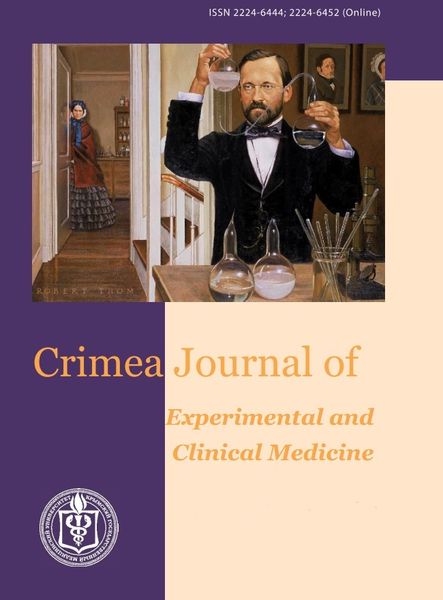Контролируемое течение бронхиальной астмы (БА) в исследованиях отмечается у 25-68% пациентов, однако, в реальной клинической практике, вероятно, данный уровень значительно ниже. Санаторно-курортное лечение является перспективным методом увеличения контроля БА, однако данные о его влиянии на различные звенья патогенеза астмы скудны. Цель. Оценка влияния санаторно-курортного лечения на клиникофункциональные показатели и состояние системного воспаления у больных с БА в постковидном периоде в условиях Южного берега Крыма. Материалы и методы. В исследование были включены пациенты с диагнозом БА. Пациенты (n=73) проходили санаторно-курортное лечение в отделении пульмонологии АНИИ им. Сеченова в г. Ялта. Перед поступлением и после проведения санаторно-курортного лечения, был произведен опрос по шкале AQLQ, а также выполнен забор плазмы крови с целью дальнейшего проведения его анализа. Изучали уровень эозинофилов и С-реактивного белка. Также были проведены функциональные исследования, в частности, пульсоксиметрия (SpO2), спирография с определением форсированной жизненной ёмкости лёгких (ФЖЕЛ), объема форсированного выдоха за первую секунду (ОФВ1), соотношение ОФВ1/ФЖЕЛ, тест с 6-минутной ходьбой (Т6МХ). Результаты. Санаторно-курортное лечение положительно повлияло на уровень качества жизни больных с астмой. Так, интегральный показатель AQLQ увеличился с 4,18 баллов до 4,38 баллов. Были выявлены улучшения показателей внешнего дыхания. ФЖЕЛ увеличилась с 92,3% до 95,9% (p = 0,01), ОВФ1 возрос с 78,1% до 82,1%, (p = 0,001). Уровень СРБ достоверно не менялся. Заключение. Санаторно-курортное лечение больных с БА в постковидном периоде в условиях ЮБК является эффективным методом для поддержания должного уровня контроля БА вне обострений, однако не влияет на уровень системного воспаления, что требует дополнительного изучения и разработки новых подходов к методикам санаторно-курортного лечения.
бронхиальная астма, санаторно-курортное лечение, COVID-19, Южный берег Крыма, системное воспаление
1. Plotnikova P. A., Pavlova V. N., Jeyranyan S. D., Teterleva I. A. Bronchialasthma: aspects of epidemiology, risk factors, variability of the clinical picture,prognosis. Student's 2021;41-2(169): 23-25. (In Russ.).
2. Gvozdenko T. A. The place of prevention and restorative treatment inmaintaining health. Health. Medical ecology. Nauka 2014;2(56):6-8. (In Russ.).
3. Pirogova M. E., Belyaeva S. N., Savchenko V. M., Bobrik Yu. V. The influence of aeropalinological factors of the air environment of the Southern coast of Crime on the results of sanatorium treatment of patients with bronchial
4. Gosteva B. O., Ilyasova G.Sh., Ivanov S.V. The role of comprehensive preventive measures in the treatment of bronchial asthma in sanatorium-resort treatment in the city of Yevpatoria. Modern aspects of the formation of
5. Ponomareva A.V., Yakovlev M. Yu., Fesyun A.D. and others. Medicinal and non-medicinal methods of treatment and rehabilitation in children with bronchial asthma (review). Russian Journal of Rehabilitation Medicine. 2021;
6. Perelman N. L. Comparative characteristics of the quality of life of patients with bronchial asthma with various types of respiratory tract hyperreactivity to physical stimuli. Bulletin of physiology and pathology of respiration. 2021;
7. Golovochesova G. A. Analysis of the main causes of uncontrolled bronchial asthma. Siberian Medical Journal (Irkutsk). 2009;87(4):128-130. (In Russ.).
8. Sobko E. V., Kraposhina A. Yu., Demko I. V. The problem of achieving control over bronchial asthma. Bulletin of physiology and pathology of respiration. 2011; (40):37-40. (In Russ.).
9. Ovcharenko S. I., Akulova M. N., Smulevich A. B. What can improve the control of bronchial asthma. Consilium Medicum. 2010;12(3):62-67. (In Russ.).
10. Ivashchenko A. S., Dudchenko L. Sh., Kaladze N. N., Mizin V. I. Phenotypes of bronchial asthma at the sanatorium stage and personalized medical rehabilitation programs. Issues of balneology, physiotherapy and therapeutic
11. Babanov C. A., Strizhakov L. A., Baykova A. G., et al. Clinical and immunological features and prognosis in various phenotypes of occupational bronchial asthma. Occupational medicine and industrial ecology. 2021;61(7):436-
12. Beloglazov V. A., Yatskov I. A., Useinova R. H. Low-intensity inflammation in the postcovoid period as a strategic goal of treatment and rehabilitation. Acta Biomedica Scientifica. 2024;9(2):24-34. (In Russ.).
13. León-Pedroza J. I., González-Tapia L. A., del Olmo-Gil E., Castellanos- Rodríguez D., Escobedo G., González-Chávez A. Low-grade systemic inflammation and the development of metabolic diseases: from the molecular
14. Abdulan I. M., Feller V., Oancea A., Maștaleru A., Alexa A. I., Negru R., Cumpăt C. M., Leon M. M. Evolution of Cardiovascular Risk Factors in Post-COVID Patients. J Clin Med. 2023;12(20):6538. doihttps://doi.org/10.3390/jcm12206538.
15. Juniper E. F., Svensson K., Mörk A. C., et al. Modification of the asthma quality of life questionnaire (standardised) for patients 12 years and older. Health Qual Life Outcomes. 2005;(3):58. doihttps://doi.org/10.1186/1477-7525-3-58.
16. Sobko E. A., Demko I. V., Kraposhina A. Yu. and others. Assessment of quality of life indicators and the role of adherence in achieving control in severe bronchial asthma. Medical advice. 2021;(16):45-51. (In Russ.).
17. Leshchenko I. V. Control of bronchial asthma: the actual problem and its solution in real clinical practice. Pulmonology. 2019;29(3):346-352. (In Russ.). doihttps://doi.org/10.18093/0869-0189-2019-29-3-346-352.
18. Barkalov S. A., Moiseev S. V., Trebuntseva L. V. The model of integral estimation of AQLQ based on latent variables. Project management in construction. 2019;4(17):91-96. (In Russ.).
19. Dudchenko L. Sh., Kaladze N. N., Yusupalieva M. M. Rehabilitation of patients with bronchial asthma with fixed obstruction at the sanatorium stage. Physical and rehabilitation medicine. 2022;4(1):41-46. (In Russ.).
20. Efimenko N. V., Abramtsova A.V., Simonova T. M., Semukhin A. N. Assessment of the functional state of the cardiorespiratory system in patients after COVID-19 pneumonia during medical rehabilitation at the resort. Modern
21. Dudchenko L. Sh., Grigoriev P. E., Solovyova E. A., Andreeva G. N.Rehabilitation of patients after a new coronavirus infection with an emphasis onrespiratory therapy. Crimean Journal of Experimental and Clinical Medicine.
22. Andreev K. A. Gorbenko A.V., Skirdenko Yu. P. and others. Markers of chronic low-intensity inflammation in healthy respondents. Modern problems of science and education. 2024;(1):26. doihttps://doi.org/10.17513/spno.33285.
23. Demko I. V., Sobko E. A., Chubarova S. V., Kublik E. S., Mineeva E. S.,Eidemiller N. S. Interrelation of indicators of systemic inflammation and cellular composition of induced sputum in a combination of bronchial asthma and
24. Beloglazov V. A., Popenko Yu. O., Shadchneva N. A., and others. Integralindicators of antiendotoxin immunity and systemic inflammation in patients with bronchial asthma with various biophenotypes of inflammation.
25. Kytikova O. Yu., Gvozdenko T. A., Antonyuk M. V. The role of systemic inflammation in bronchial asthma and obesity. Clinical medicine. 2018;96(9):784-790 (In Russ.). doihttps://doi.org/10.18821/0023-2149-2018-96-9-784-790.
26. Voennov O. V., Zubeev P. S., Mokrov K. V., Fedorov M. E., Gunderchuk O.N. The effect of systemic inflammation on the risk of acute respiratory failure and death in patients with COVID-19. Medical Bulletin of the Ministry of





